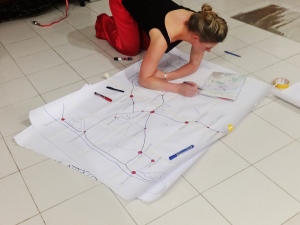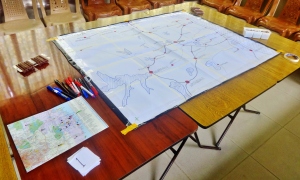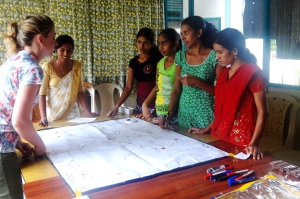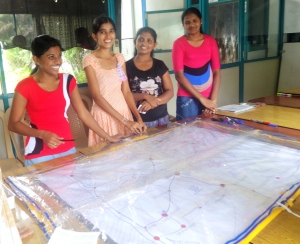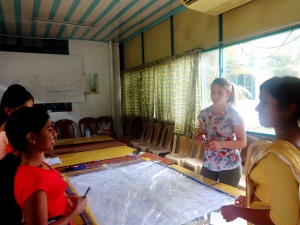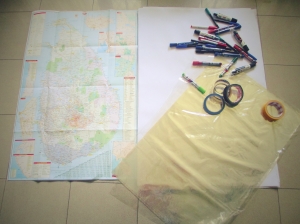One of the managers of the factory, Lahiru Sir, gave me a detailed tour of the factory today, and showed me the nearby washing plant. Although Baba G has also given me a tour of the factory, I decided it would be good to get a tour from Lahiru Sir too, so I could ask him questions as we walked around in a walking tour style interview. Lahiru Sir was very keen to show his knowledge of the factory though, having only been employed for a week or so, so much of the tour was taken up by him explaining operational functions of the various parts of the factory.
I managed to ask a few questions as we were going around. He says about 95% of the workforce are women, and that men are generally employed to do the jobs involving heavy machinery, which are higher risk. Women employees are mostly young, although a few are older. A lot of the women are wearing fine gold jewellery, and most have long hair, tied back in braids or pony tails. In the washing plant, as it’s much more heavy duty machinery, the vast majority of the 200-strong workforce are men. Some of the employees come from Colombo, but these tend to be those in management, who will live in Ampara for work but commute back to Colombo once or twice a month to see their families. I later asked Bandula Sir why their families didn’t move to Ampara too, and he explained the education system was better in Colombo, so it was better for his family to be there. The factory has 25 production lines, with roughly 45 employees to each production line, including 35 machine operators, 3 helpers, 2 checkers, and then a leader, time checkers and a supervisor.
All three religions are employed in the factory: Tamil, Muslim and Sinhala. At one point Lahiru Sir called over a Muslim girl from one of the production lines. She must have wondered what on earth was going on as she stood next to us whilst Lahiru Sir spoke to me about the communications between the workers. He told me they can’t speak English very well, and that I could ask simple questions to them but they might not understand. He said some words to her too in Sinhalese, although I’m not sure what, and then let her go back to her machine. All I could do really was smile reassuringly at her, and she did smile back, but I mentally kicked myself afterwards for not even attempting to introduce myself to her in Sinhalese. I know how to say ‘My name is Lucy’ now, thanks to Baba G – I’ll make sure to put it to practice tomorrow in the packing line! Despite this girl’s apparent lack of understanding of English, Lahiru Sir said the girls could speak English well enough to understand factory commands, especially seeing as there are minimum qualification entry levels required for employment in the factory. I noticed that many of the women would take umbrellas with them if they ventured outside, to keep the sun off them.
Once the tour was finished, Lahiru Sir introduced me to Gihan Sir, a manager in the HR department. He provided me, verbally, with a few statistics regarding employees. There are 1572 employed in the factory, of which 321 are male (although later I was given different figures). They recruit people aged between 17 and 35, although most of them are at the younger end of the age scale because many join straight after they leave school. They will allow new recruits who are older than 35 if they have certain skills, but will not recruit unskilled workers above this age. Gihan Sir told me that of the workers, 350 are Muslim and 300 are Tamil (although again, I was told different figures later). The factory is structured so that there are 23 managers and deputy-heads, 8 assistant managers, 24 supervisors, 20 leaders and 200 sub-leaders. Working hours are 7am until 5:30pm 6 days a week, with regular tea breaks and a lunch break. Work doesn’t actually start at 7am though – I’m to experience the morning routine tomorrow… A few hundred employees live in Ampara, and the rest are collected on company owned buses, of which there are 15 in total.
I glanced through some employee files too, and asked Gihan Sir if he had a map of the bus routes, which he said he did:
Lucy: “Do you have a map of the bus routes? Where the buses go?”
Gihan Sir: “You want math?”
L: “No, map.”
G: “Math, yes?”
L: “No, map.”
G: [Head waggle and smile]
L: “…A map…? Bus routes…?”
G: “Oh! M. A. P. Map! Yes, yes, we have.”
He asked one of the women who work in the HR department something, and we waited for about 15 minutes, although I’m not entirely sure what for, and then he changed his answer and said they didn’t have a map. Aiyooo, language problems!
I noted, whilst walking up and down the production lines, watching the workers watching me, that they would only smile at me if I smiled at them, but when I did smile at them I got huge smiles in return. A reminder that smiles can go such a long way, and the phrase ‘Smile, and the world smiles back’ is often very true.
I recognised one man from yesterday: a checker at the end of one of the lines. I only just glimpsed him out of the corner of my eye, but then made sure to pause and smile and nod at him. He looked genuinely pleased when I recognised and acknowledged him, which made me think how important it is, in a factory so large, to be noticed and remembered. I think that because of the way the production lines are arranged, with a team set-up, employees are less likely to feel like faceless production units, but I think it’s still important that I try to remember and acknowledge as many workers as I can.
The production lines are set up in a long line, with pairs of workers in the long chain. Each worker has a specific role, be it ironing pockets flat, or sewing belt loops on, to make the process as efficient as possible. It also means that there won’t be much if any rotation of position, so communication is limited to the four people closest to you during operative hours, and even then communication must be a little difficult as their heads are often bowed over their machines in concentration. This said, I wandered back through at around 10:30 and workers from four of the production lines had vanished, lights were off, and machines deserted. I asked where they all were, and it was one of their tea-breaks. Tea breaks really do seem frequent.
I was shattered today; couldn’t get to sleep last night, and woke up itching because mosquitoes have decided to attack my feet. I quite literally have two bites per toe. I thought I’d be asleep by 9pm tonight, and I lay down trying to sleep for a good hour, feeling very tired, but my mind was buzzing still. This is one aspect of social research that I hadn’t really considered or expected; the research very quickly takes over so that you’re always thinking about it, making it very hard to actually shut down. It’s now midnight and I’m really not looking forward to a 6am start tomorrow.
I had an ad-hoc interview with Bandula Sir, another HR manager, later on in the afternoon, after I’d taken a trip into town to see if I could find a map of the Eastern Province (no luck). It was a really helpful, interesting interview, which I shall endeavour to tell you about in the next couple of days. I had thought it would be a negative thing, to hold a spontaneous, unrecorded interview, and was initially reluctant to get into any long discussions with him. I wasn’t able to write down everything Bandula Sir said, but I was able to get most of it. He seemed in no hurry to get anything done, and we were sitting in his office. He’s a long serving manager in the factory, and is quite senior now and very sweet. He didn’t rush me to think of questions, and I didn’t rush him for answers, so there were lots of long silences as I thought about things and wrote down notes. This didn’t seem to matter in the slightest. The long but unawkward silences actually seemed to prompt Bandula Sir to think more about his answers and my research topic, so after long pauses, he would add in extra bits of information. We were also waiting for some print outs of employee statistics, and once we’d both had a cup of tea and had been chatting for well over an hour, I really couldn’t come up with any more questions.
If you have any questions for me, please do fire away! For now though, it’s attempt 2 at getting to sleep. Important day tomorrow!
7.283333
81.666667


